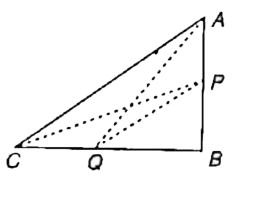In a right triangle ABC right angled at C, P and Q are points on the sides CA and CB respectively, which divide these sides in the ratio 2:1. Then, which of the following statements is true?
9AQ2=9BC2+4AC2
9AQ2=9AC2+4BC2
9AQ2=9BC2+4PQ2
9AQ2=9AB2−4BP2
The correct Answer is:B
To solve the problem step by step, we will follow the reasoning provided in the video transcript.
1. Draw Triangle ABC:
- Start by sketching a right triangle ABC where C is the right angle. Label the vertices as A, B, and C.
2. Identify Points P and Q:
- Mark point P on side CA and point Q on side CB. According to the problem, these points divide the sides in the ratio 2:1.
3. Determine Lengths:
- Since P divides CA in the ratio 2:1, we can denote the length of CA as 3x (where x is a unit length). Therefore, AP = 2x and PC = x.
- Similarly, since Q divides CB in the ratio 2:1, we can denote the length of CB as 3y (where y is another unit length). Thus, BQ = 2y and QC = y.
4. Apply Pythagorean Theorem in Triangle ACQ:
- Triangle ACQ is a right triangle with the right angle at C. We can apply the Pythagorean theorem here:
AQ2=AC2+QC2
5. Substituting Values:
- We know:
- AC=3x
- QC=y
- Substitute these values into the Pythagorean theorem:
AQ2=(3x)2+(y)2
- This simplifies to:
AQ2=9x2+y2
6. Express QC in terms of BC:
- Since QC = y and we have previously established that QC = 1/3 of CB, we can express y as:
y=13⋅CB
- If we denote CB as 3y, then:
QC=y=13⋅3y=y
7. Final Equation:
- Substitute QC back into the equation:
AQ2=9x2+(13⋅3y)2
- This leads to:
AQ2=9x2+19(3y)2
- Simplifying gives:
AQ2=9x2+19(9y2)=9x2+y2
8. Conclusion:
- We have derived the relationship 9AQ2=9AC2+4BC2, which matches one of the statements provided in the options.
- Start by sketching a right triangle ABC where C is the right angle. Label the vertices as A, B, and C.
- Mark point P on side CA and point Q on side CB. According to the problem, these points divide the sides in the ratio 2:1.
- Since P divides CA in the ratio 2:1, we can denote the length of CA as 3x (where x is a unit length). Therefore, AP = 2x and PC = x.
- Similarly, since Q divides CB in the ratio 2:1, we can denote the length of CB as 3y (where y is another unit length). Thus, BQ = 2y and QC = y.
- Triangle ACQ is a right triangle with the right angle at C. We can apply the Pythagorean theorem here:
AQ2=AC2+QC2
- We know:
- AC=3x
- QC=y
- Substitute these values into the Pythagorean theorem:
AQ2=(3x)2+(y)2
- This simplifies to:
AQ2=9x2+y2
- Since QC = y and we have previously established that QC = 1/3 of CB, we can express y as:
y=13⋅CB
- If we denote CB as 3y, then:
QC=y=13⋅3y=y
- Substitute QC back into the equation:
AQ2=9x2+(13⋅3y)2
- This leads to:
AQ2=9x2+19(3y)2
- Simplifying gives:
AQ2=9x2+19(9y2)=9x2+y2
- We have derived the relationship 9AQ2=9AC2+4BC2, which matches one of the statements provided in the options.
Topper's Solved these Questions
- TRIANGLES BOOK - S CHAND IIT JEE FOUNDATIONCHAPTER - TRIANGLES EXERCISE - Question Bank
30 Videos
- TIME AND WORK BOOK - S CHAND IIT JEE FOUNDATIONCHAPTER - TIME AND WORK EXERCISE - Self Assessment Sheet - 20
10 Videos
- TRIGONOMETRICAL RATIOS BOOK - S CHAND IIT JEE FOUNDATIONCHAPTER - TRIGONOMETRICAL RATIOS EXERCISE - Self Assessment Sheet - 40
1 Videos
Similar Questions
In a right triangle ABC , right angled at C, P and Q are the points of the sides CA and CB respectively , which divide these sides in the ratio 2:1 Prove that
9AQ2=9AC2+4BC2
View SolutionIn a right triangle ABC , right angled at C, P and Q are the points of the sides CA and CB respectively , which divide these sides in the ratio 2:1 Prove that
9BP2=9BC2+4AC2
View Solution
Knowledge Check
In right angled ΔABC,∠B=90∘, if P and Q are points on the sides AB and BC respectively, then :
 AAQ2+CP2=2(AC2+PQ2)BAQ2+CP2=AC2+PQ2C(AQ2+CP2)=12(AC2+PQ2)D(AQ+CP)=12(AC+PQ)
AAQ2+CP2=2(AC2+PQ2)BAQ2+CP2=AC2+PQ2C(AQ2+CP2)=12(AC2+PQ2)D(AQ+CP)=12(AC+PQ)In right angled ΔABC,∠B=90∘, if P and Q are points on the sides AB and BC respectively, then :
 AAQ2+CP2=2(AC2+PQ2)BAQ2+CP2=AC2+PQ2C(AQ2+CP2)=12(AC2+PQ2)D(AQ+CP)=12(AC+PQ)
AAQ2+CP2=2(AC2+PQ2)BAQ2+CP2=AC2+PQ2C(AQ2+CP2)=12(AC2+PQ2)D(AQ+CP)=12(AC+PQ)The sides of a triangle ABC are positive integers. The smallest side has length 1. Which of the following statement is true ?
AThe area of ABC is always a rational numberBThe area of ABC is always an irrational numberCThe perimeter of ABC is an even integerDThe information provided is not sufficient to conclude any of the statement A, B or C above
In a right triangle ABC , right angled at C, P and Q are the points of the sides CA and CB respectively , which divide these sides in the ratio 2:1 Prove that
9(AQ2+BP2)=13AB2
View SolutionPQR is a triangle right-angled at Q. If X and Y are the mid-points of the sides PQ and QR respectively, then which one of the following is not correct?
View SolutionIn a triangle ABC, right angled at C, find the value of tan A + tan B in terms of the sides a,b,c.
View SolutionP and Q are the mid-points of the sides AB and BC, respectively, of ΔABC, right angled at B. Then:
View SolutionP and Q are points on the sides CA and CB respectively of ABC , right angled at C . Prove that AQ2+BP2=AB2+PQ2 .
View Solution
